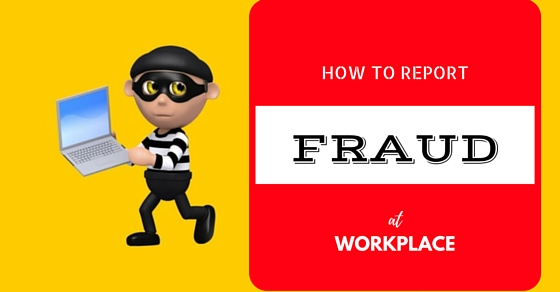No matter how stringent are the rules and policies of the organization, fraud at workplace is something unavoidable at times.
Be it a small organization, limited firm, partnership, or even non-profit, all of them have faced fraud at some point of time. It is a serious issue, as it has several impacts including financial losses and harm to reputation.
Most frauds are ongoing. Once the fraudster starts, its hard for him or her to stop. He will start by stealing say $100 at first and later raising the amount. Fraudster gains his confidence and willingness to steal larger amount as his fraud goes unnoticed.

Internal controls are often proven to be ineffective as business changes at a fast pace, new products, services, news positions, new employees; change is the only constant thing in the organizations.
Having a year old internal control will hence be total waste. Fraud at workplace happen when the managers and seniors are busy in their daily activities and could not pay much attention to the employee/s.
1) Some statistics related to fraud at workplace:
- In 37% of the cases the fraudster is an employee, who has been employed for more than 10 years
- Personal problems like gambling, debt and drugs often trigger employee to commit fraud.
- Most fraud involves theft of cash rather than any other tangible asset.
2) Triggers of fraud:
Donald R Cressey, an American criminologist, devised a theory called ‘fraud triangle’, it describes the reasoning behind the employee’s decision to commit fraud. It is classified as follows:
a) Pressure:
Pressure of hard targets to meet, pressure of working hard to get promoted or some personal factors like gambling and debt leads employee to commit fraud. Committed fraud may not resolve the building pressure but the fraudster perceives it which may help him relax or feel good about himself.
b) Rationalization:
The fraudsters who fall in the category of rationalization do not consider themselves as a criminal but perceives themselves as the victim of circumstances. They convince themselves in such a way that they are not guilty to commit the crime.
Rationalization occurs based on external factors like- family difficulty or pressure of financial support to the family.
c) Opportunity:
A golden opportunity of committing a fraud and knowing he will go unnoticed provokes the employee to do it. Bad culture and environment of an organization like lack of internal hierarchy and control, blame culture will motivate the fraudster further to take the step.
3) Types of Fraud at Workplace:
The following are few types of frauds and workplace theft that occurs
a) IT Fraud:
Organizations often store the key data of their clients or financial information on computers.
Hacking into the servers and altering the websites is a piece of cake for an expert hacker. The sensitive data can easily be accessed if internal security is weak.
b) Identity Fraud:
Impersonating a person or whole organization by identity theft statistics is one of the type of workplace fraud. The fraudster will deceive the customer, alter the company decisions, order goods and do stuff for his own benefit.
An organization must have strict control on the passwords and the important data related to identity.
c) Manipulation of Accounts:
Presenting a financial report by altering their true picture for the sake of own financial gain, will come under the manipulation of accounts. The fraud employee makes changes in the purchase of stocks or sales.
d) Petty Fraud:
Every organization faces petty frauds. Employees do not consider themselves guilty as they think doing this type of fraud possesses any loss to the organization.
It includes things like stealing office stationery, taking personal printouts, altering the bills which are reimbursed by the company. A small fraud by all the employees will together prove to be a big loss to the organization.
4) Warning Signs of Fraud at Workplace:
All frauds happen due to a lack of attention from the people around. Here are a few warning signs which may raise your suspicion towards the employee committing fraud. Some common warning signs of fraud are as follows.
- An employee living beyond his means
- Frequent cash discrepancies which are unexplained
- Billing complaints from customers
- Complaints from vendors regarding payments
- Sudden rise in the costs incurred on advertising, consulting
- Destroyed or missing checks
- Unreconciled data in ledgers
- An employee who never takes a vacation
5) Effects or Consequences of Frauds at Workplace:
Fraud is necessary to be addressed on time. It is necessary to take steps for preventing fraud, as it has the following impacts on the organization.
a) Financial:
The loss of funds or the goods may affect the share price if the loss is large in number. High loss of funds suggests that strict rules and keen eye on employees is must to have.
b) Reputation:
Fraud at the workplace spoils the reputation of the organization. Clients and prospects lose faith and may not have a long term association. It’s obvious that people want to associate with the company which has ethical employees and the work is smooth.
c) Employee Morale:
A fraud that caused high loss definitely affects employee morale. The internal trust of employees is damaged. Employers will keep tabs on all employees including honest ones, which may make them feel bad.
Attrition rate also rises as employees do not feel secure in the environment. Retaining the employee and gaining their trust again is a difficult task for HR and the management posts the fraud.
6) Fraud Prevention Plans at Workplace:
There are 10 rules one can follow to prevent fraud at the workplace or theft.
a) Have a written contract:
If the organization has one or more than one partner, it is wise to have a written contract by consulting a corporate lawyer.
It should include the following things:
- Identification of all the partners
- Description of business
- Responsibilities of each partner towards the company
- Detailed explanation on compensation
- Reimbursable expenses
- Information related to insurance
- Confidentiality clause
- Copyright and intellectual property
- Clause of modification
- Termination of employment
- Financing and
- Signatures.
Having a written document helps to have clear terms with all the partners and thereby reducing the fraud and conflicts.
b) Select good employees:
Selecting wise employees with moral values will help reduce or eliminate fraud at the workplace. But recognizing these kinds of employees takes time and effort. Make sure to take the necessary steps for reforming the hiring methods so as to select good employees. Few tips are as follows.
- Invest time in judging and examining the candidate, one can do a detailed reference check
- Seek trustworthy employees
- Pay attention to people who will be directly handling the cash, accounts and stocks.
- Choose motivated employees with the best interest for the organization
- Have realistic expectations from the employees, and be clear on job description, line of control, working hours and policies.
- Offer salary as per industry standards.
c) Establish a Zero tolerance policy:
Clearly specify in the company rule book the implication if found committing a fraud. Ensure that employees understand them well. If needed arrange a training session that will help them get clarity.
One can also establish a good communication channel for employees where they can file the report. Assure them the information will be handled confidentially. It is wise to set up an anonymous phone service where employees are assured that their identity will not be revealed.
d) Keep an eye open
Keep an open eye and check randomly on accounts, purchases, sales department. Have preparation of payroll done by two people from different teams. Also avoid entrusting the entire accounting to a single person.
Assign the task of counting the inventory to someone else other than the person who handles the inventory maintenance. Make sure employees leave on time after their shift is over. Keep eye on the employee with unusual behavior.
e) Practice good accounting:
Good accounting practices like the ones mentioned below will help reduce fraud at the workplace to a great extent
- Purchase orders – Use numbered purchase orders
- Credit cards – All expenses incurred on credit cards must require authorization
- Cheques – Be the signing authority of all cheques.
- Expense control – Expenses higher than 1000 INR should require proper approvals
- Reimbursements – Allow employees to stay in pre-approved hotels and restaurants only, wherein they will not get a chance of producing fake bills.
- Bank statements – Get the sensitive information and letters posted to home address rather than workplace
- Cash drawers – Do not keep too much petty cash lying around at the workplace; have surveillance monitoring employees’ actions.
f) Manage the merchandise and equipment:
There are high probability that the merchandise and goods will get stolen if not kept an eye on. A few tips which help reduce the risk is as follows.
- Enter the received items in a book or an inventory system
- Keep the delivery items sealed, add a note “do not accept if packing is tarnished”.
- Resolve the complaints related to invoice, discounts and vendor payments, keen observation may help you to catch the culprit red-handed.
- Audit the inventory
- Ensure to have important goods locked and guarded.
g) Use security systems:
- Install a video surveillance systems in key areas like accounts, lockers, inventory, employee records, and server rooms. Make sure the quality of the video and images produced by the camera is of good quality.
- Place posters like ‘ you are under video surveillance ‘
- Have good lighting – cameras require good light to capture quality images. Also a well-lit area demotivates employees to sneak at places that they are not supposed to visit.
h) Control access control:
- Combinations, Keys and access codes: Never give keys and combination codes to anyone other than trusted employees, change the combinations when employees leave.
- Duplicate keys: Never make too many duplicate keys, keep a note of the keys whenever circulated.
- Get controlled locks: The keys to the controlled locks are hard to duplicate, it costs more but are worth the investment.
i) Manage data access:
Be attentive of hackers accessing your personal information. Payroll list, company revenue, bank statements, pricing list should all be kept protected.
To control access to your computer system:
- Assign passwords to each computer and change it often
- Store laptops under locked cabinets
- Keep copies of the key data stored somewhere safe.
- Use a digital signature in emails.
j) Manage telephone lines:
Making personal calls, making long-distance calls from the company’s phone can also be termed as a fraud. Have clear policies defined for the use of phone calls. Also, do not permit everyone to make calls.
k) Employer options when theft is suspected:
Having strict internal controls help identify the fraud at the workplace and theft faster. When you find the culprit following actions can be taken
- Send employee on a leave
- Suspend the employee from work
- Transfer the employee to another location
- Terminate the employee, when you have solid proofs
Types of Fraud and Theft:
Employee fraud is one of the biggest threats that most employers face and it is not something that is unusual. The best way to prevent such kinds of things is to identify it and take necessary action.
According to the survey done by ACFE on employee fraud, companies lose almost 5% of their revenue every year due to employee fraud. Though the chances of fraud is possible in any department, the senior-most employees in finance, accounts are the people who are seen mostly doing frauds.
Employee fraud is a crime that should not be entertained in any manner and organizations need to take strict action regarding it.
Types of fraud schemes:
- Bribery and Corruption
- Data Theft
- Payroll Fraud
- Accounting Fraud
- Vendor Fraud
- Asset Misappropriation
1. Bribery and Corruption:
Bribery and corruption can engage employees of the company to perform fraud and theft at the workplace.
- Product Substitution
- Shell Company Fraud Schemes
- Kickbacks
- Bribes
Preventing & Detecting Bribery and Corruption:
- An employee who have great work ethics should be rewarded
- Instruct all employees to stay away from any such antisocial things
- Review product substitution red flags
- Implement risk assessment for a better view
- Take strict action on employees breaking workplace disciplines
- Make clear that corruption and bribery would not be tolerated
- Infuse best work ethics in your employees
2. Data Theft:
- Theft of Personally Identifiable Information (PID)
- Theft of Customer or Contact Lists
- Trade Secret Theft
Preventing & Detecting Data Theft:
- Instruct employees to save and secure their data while leaving their desk
- Make use of strong passwords so as to avoid others accessing the important data
- Clear all the data from electronic devices and make hard copies of it and store them in lockers
- Research and buy good software to secure confidential data
- Take help of the IT department when making a transfer or download of data
- Adopt an alert management system using IT controls for safeguarding important information
3. Payroll Fraud:
The theft or fraud done in the payroll process.
- Paycheck Theft
- Timesheet Fraud
- Advance Fraud
- Ghost Employee Schemes
Preventing & Detecting Payroll Fraud:
- Creating individual tasks for reconciling payroll accounts and making payroll checks
- Recheck of payroll system to update all the employee information correctly
- Use data analytics to the payroll system
- No employees are given permission to make changes in the payroll system
- Managers should review all the employee timesheets
- All the payroll accounts and balance sheets need to be reviewed every quarter
4. Accounting Fraud:
This a type of fraud done by employees who can have access to company accounts. They carry out frauds and use accounts to screen it out.
- Accounts Receivable Fraud
- Double-Check Fraud
- Personal Purchases
- Fake Supplier
- Accounts Payable Fraud
- Embezzlement
Preventing & Detecting Accounting Fraud:
- Implement any automatic system for identifying faults
- Use any third-party assistance to review accounts
- Choose the best employees for your accounting team
- Execute timely audits
- Make use of best internal constraints for accounting works
5. Vendor Fraud:
Vendor fraud is the type of fraud committed by employees of the organization along with vendors. It can also be carried out by vendors also.
- Price Fixing
- Overbilling
- Check Tampering
- Bribery and Kickbacks
- Billing Schemes
Preventing & Detecting Vendor Fraud:
- Check whether the billing applied by the vendor is reasonable or not
- Execute a master vendor file review
- Make use of data mining for accurate stats
- Recheck the addresses of employees and vendors
- Choose a reliable and honest vendor
- Audit the vendor files regularly
- Do a strong background check before finalizing a vendor
6. Asset Misappropriation:
- Asset misappropriation can also be termed as inside fraud and mostly deals with asset theft of the organization.
- Personal Use of Company Vehicle
- Commission Fraud
- Health Insurance Fraud
- Workers’ Compensation Fraud
- Payment Fraud
- Procurement Fraud
- Expense Account Fraud
- Expense Reimbursement Fraud
- Theft of Services
- Theft of Cash
- Inventory Theft
- Check Tampering
- Check Kiting
- Check Forgery
Preventing & Detecting Asset Misappropriation:
- Introduce a hotline that helps employees report any kind of malpractices
- Checks need to be stored in a cabinet
- Void checks need to be destroyed
- The payment of commissions need to be given only after the delivery of the goods
- Timely audits need to be performed
- Rotational duties need to implemented for account department employees
- Work of check preparer and check signer should be different
- Exercise checks and balances
- Background checks need to be strong for new joiners
What to Do after Termination of Employee?
Post terminating a fraud employee, you can take following steps-
a) Suing the employee:
You can sue the employee for fraud, you need to have enough roofs to do that, and you can seek to recover your losses. The authorities may seal the bank account and passport of the fraudster, till the issue is resolved.
b) Recovering losses after a criminal conviction:
Local law will investigate the case and ask the employee to back the losses if found to be guilty. An employee can get prosecuted if he fails to replay back to the employer.
c) Recovering through insurance:
Theft insurance protects the employer from all current and former employees, partners, members and management. Though it will not include- accounting errors, government raids.
Conclusion:
Thus we saw the causes, impacts, prevention and steps post fraud. One should not panic when you suspect fraud at the workplace. Have strict internal controls and reevaluate them from time to time. Keep a keen eye on employees, having surprise checks will help you do that. The rules and policies against fraud and theft should be written with diligence. Make sure your employees know the policies and the repercussions of committing the fraud at the workplace.
If you suspect a fraud act carefully and collect enough evidence, the termination will call for solid proofs to be presented. File for a case or repayment only if you think it’s worth the time and money. Not everyone is a thief, yet fraud at the workplace is very common. It is rightly said “prevention is better than cure”, and this principle fits well for workplace fraud and theft.






































